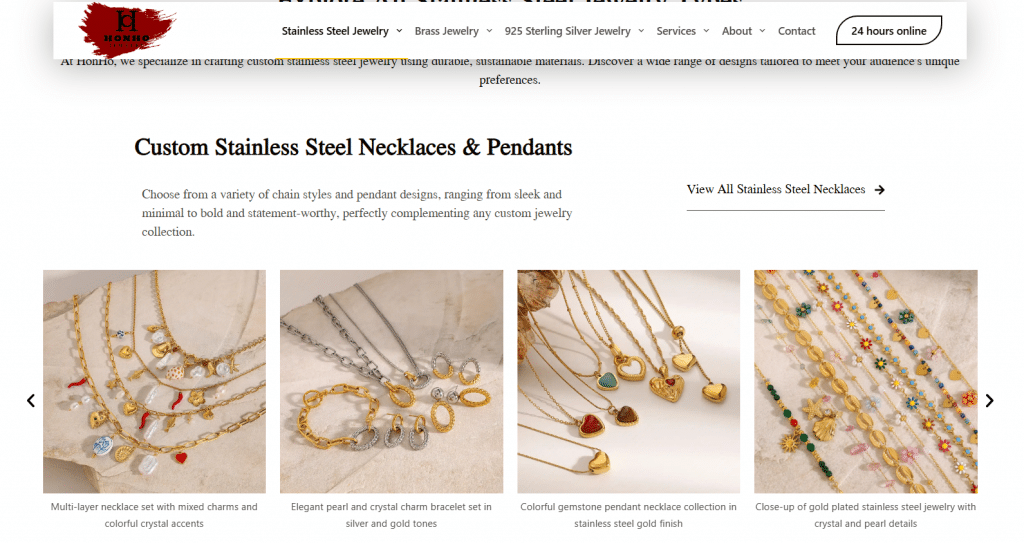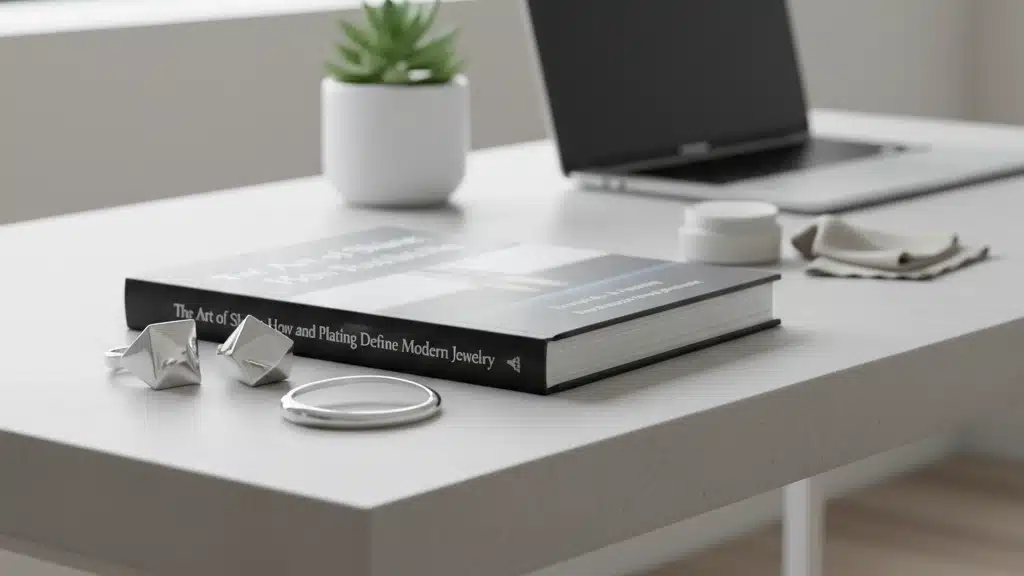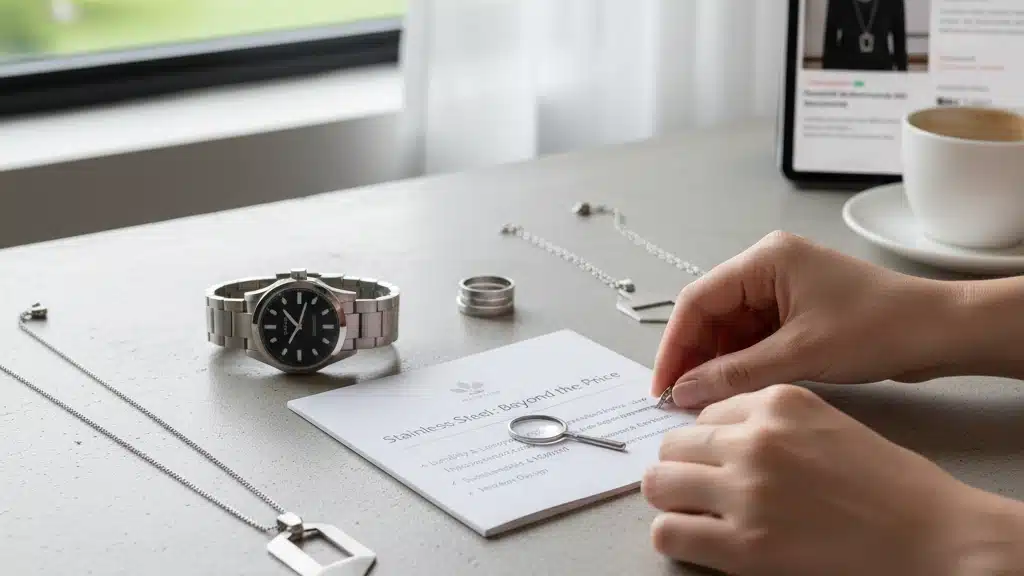Does Gold Dipped Jewelry Tarnish? The Complete Guide to Protection & Care


Does Gold Dipped Jewelry Tarnish? Understanding the Truth Behind the Shine
Gold dipped jewelry provides a cost-effective alternative to enjoy a similar luxurious look as gold without the cost association. But for many customers, the question arises about durability, and they ask, does gold dipped jewelry tarnish? The short answer is yes; however, knowing the reasons behind this phenomenon and being able to prevent this from happening can add significant years to the life span and shine of your jewelry.
In this ultimate guide by HonHo Jewelry, we will be digging into the nit-grit of gold dipped jewelry tarnish, the science of it, and solutions for you to care for your pieces so the shine lasts for years.
What Is Gold Dipped Jewelry? Understanding the Basics
In order to get into tarnishing affairs, we need to know what gold dipped jewelry is. Gold dipped jewelry (also used interchangeably with gold plated) refers to jewelry where a layer of gold is applied over a base metal such as brass, copper, sterling silver or an alloy.
Gold Dipped vs. Gold Plated: Is There a Difference?
Although these terms are commonly used interchangeably in the jewellery industry, there can be subtle differences:
- Gold dipped meaning is a process in which jewelry is meant to be literally dipped in molten gold or a gold solution to achieve the thin layer of gold.
- Gold plated is typically a process of electroplating, where an electric current is used to plate gold onto the base metal.
In practice, though, the terms overlap: both yield a thin layer of gold over a less expensive base metal. The thickness of that layer of gold is usually between ½ to 2½ microns (very thin, approximately 1/1000 of 1 mm.).
What Is Gold Dipped Jewelry And Why Does It Tarnish?
Gold plated and gold dipped jewelry tarnish mainly because the ultra-thin gold layer gradually wears off, exposing the underlying base metal to air, moisture, and chemicals. While pure gold (24K) never tarnishes or corrodes, the base metals beneath gold plating will tarnish and corrode.
The Science Behind Tarnishing

Base metals, such as copper, brass or silver, react to oxygen, sulfur or other elements found in the air, producing tarnish – generally a darkening, discoloration or dullness of the jewelry surface.
Base metals tarnish in different ways:
- Metals containing copper tend to form a greenish coating.
- Silver alloys also usually blacken or yellow
- Brass often gets a brownish stain (or patina)
Causes Of Faster Gold Dipped Jewelry Tarnishing
Here are a few reasons why your gold dipped jewelry may tarnish faster:
1. Moisture and Chemical Exposure
Water, particularly chlorinated pool water or saltwater can prove harmful to that thin layer of gold and it can degrade fast. Or chemicals that can be found in:
- Perfumes and colognes
- Lotions and creams
- Household cleaners
- Hairsprays
- Hand sanitizers
All of these may hasten the destruction of the gold above, exposing the base metal beneath.
2. Biochemistry, body science, perspiration
Each individual has a pH level and chemical composition of their skin. Individuals with more acidic skin commonly have this tendency, and it may lead to more enhanced tarnishing. Profuse sweating, which is heavy in salts and acids, can also hasten the process.
3. Frequency of Wear
In other words, the more you use gold dipped jewelry, the more quickly it will become dull. Regular contact with skin, contaminants, and normal wear-and-tear lead to this top layer of gold gradually being worn away.
4. Storage Conditions
Storing in a humid location or with other pieces of jewelry that can scratch will accelerate tarnishing. This layer of gold can easily be scratched and what the person sees is the base metal beneath.
How to Know If Your Gold Dipped Jewelry Is Tarnishing

The early signs of tarnishing in jewelry made of gold (with a low grade below 23k) include:
- And spots or areas turning darker, green or black.
- Dullness: The original shiny yellow gold luster is gone
- Green or black stains on body after donning the jewelry
- Uneven look due to the gold layer wearing out in spots
Tarnishing – How to Keep Gold Dipped Jewelry from Tarnishing

Although gold dipped jewelry will eventually tarnish with regular wear, these preventative tips can greatly prolong its life:
1. Proper Wear Habits
- Remove jewelry before swimming, exercising and showering
- Spray yourself down with fragrance (and lotion, and hairspray) before adorning yourself in jewelry
- Wear jewelry last when dressing and first when you get home
- Do not wear during high sweat activities
2. Optimal Storage Solutions
- Air should be minimised by storing in airtight containers or Ziploc bags
- Keep anti-tarnish strips in your jewelry box
- Muffler felts (these separate the ceramic discs) are usually not available in proper replacement parts, so in case you’re missing some, and the last thing you want is the pieces rubbing each other, especially when they get hot, so make sure to keep them separated, don’t let them rub on each other, otherwise you will have scratches on it!
- Store in a cool, dry place, away from bathroom humidity
3. Regular Cleaning Routine
- Wipe gently with a soft, dry microfiber cloth after each wear
- To clean more thoroughly, use mild soap and water (dry well)
- Do not use any disgusting chemicals or scrubbing materials
- Opt for niche gold jewelry cleaning products that state their safety for plated goods
Advanced Shielding: Tarnish-Free Finishes
Some dipped gold jewelry has additional protective layers, which can help signifcantly prolong its life:

E-Coating Technology
E-coat (electrophoretic coating): This is a transparent polymer protective layer applied over the gold-plated surface. This provides a shield from moisture, chemicals, and scratches. E-coated jewelry typically lasts 3-5x longer than regular gold plated jewelry.
PVD Coating
At the other end of the scale we have physical vapor deposition (PVD), an advanced technology that bonds gold to the base metal at the molecular level. That makes for a much more hardened finish that:
- 3-7x more scratch-resistant than traditional plating
- Offers excellent tarnish resistance
- Holds color and shine significantly longer
- More eco-friendly than electroplating
We use coating technologies on selected pieces for ultimate durability and customer experience at HonHo Jewelry.
Seeing Tarnished Gold Dipped Jewelry?
When your dipped gold jewelry eventually tarnishes, you have a few options:
1. Professional Replating
Jewelers can clean off the tarnish and replated the piece with a new layer of gold. This usually ranges from $20-$80 depending on the size and details of the piece.
2. DIY Cleaning Methods

These approaches might help with light tarnishing:
- Slight soup solution: Hide a couple of drops of mellow dish soap in warmed water
- Baking soda paste: Mix baking soda with water to create a paste for tougher tarnish
- Commercial jewelry cleaner: Use a product made specifically for gold plated cleaners
3. When to Replace
With very inexpensive pieces, for example, replacing them may make more financial sense than replating. If the base metal has begun to show any significant corrosion, or the piece is of sentimental value, I would recommend upgrading from base metal to gold filled or solid gold options.
Gold Jewelry, Skin Allergies and the Need to Know
Tarnished gold dipped jewelry has been known to cause skin allergies.
Base Metals and Their Common Allergens
When this gold layer wears off, exposed base metals may lead to allergic reactions. Here are some of the most common offenders:
- Nickel: The most common cause of metal allergies
- Copper: May cause green staining on skin and mild irritation
- Zinc: Less common but still have those who are sensitive react
- Signs of Metal Allergies
Signs of reaction to dip jewellery:
- Skin redness
- Itching or burning sensation
- Rash or small bumps
- Dry patches of skin
- Swelling
If you notice any of these signs, take off the jewelry immediately and wash the area with mild soap and water.
Understanding Different Types of Gold Jewelry for Wise Investment

To help you better understand how gold dipped jewelry stacks up against other types of gold jewelry so you can make informed decisions about your purchases, here is a quick guide to get you started:
| Type | Gold Content | Durability | Tarnish Resistance | Price Range | Best For |
|---|---|---|---|---|---|
| Solid Gold | 100% throughout | Excellent | Excellent | $$$$ | Long-term investment |
| Gold Filled | 5% gold (100x thicker than plated) | Very Good | Very Good | $$$ | Daily wear |
| Gold Vermeil | Gold over sterling silver | Good | Good | $$ | Regular wear |
| Gold Dipped/Plated | 0.05% gold or less | Fair | Poor | $ | Occasional wear |
At HonHo Jewelry, we have various options from these categories for your needs and budget.
Gold Filled Vs Gold Dipped Jewelry: Is It Worth It?
Although gold dipped jewellery does tarnish with time, it provides another inexpensive way to get the appearance of gold. When well cared for, and with realistic expectations, these pieces offer great value in many cases, particularly for:
- Trendy styles you might choose to update seasonally
- Experimenting with new trends with little to no financial commitment
- Special occasions to wear here and there
- Adding affordable accent pieces to your fine jewelry collection
Now that you know how gold dipped jewelry works in general and what the best care methods for your specific pieces are, you can help ensure they last and shine for as long as possible.
Common Questions Related To Gold Dipped Jewelry Tarnishes
How long does gold dipped jewelry take to tarnish?
Gold dipped jewelry can last anywhere from 6 months to 2 years (or more) with proper care and routine, again depending on the quality of the plating, how often you wear it and how well you care for it. Thicker plating on higher-quality pieces, for example, will naturally last longer.
Can I wear gold dipped jewelry in the shower?
No, you shouldn’t shower with gold dipped jewelry. Water, particularly hot water with soap and shampoo, can contribute to the erosion of the gold layer, exposing the base metal to tarnishing.
What causes gold dipped jewelry to turn my skin green?
That green tinge appears when the acids in your skin come into contact with the copper used in the base metal once the gold layer has faded. This reaction produces copper oxide that is colored green. It won’t hurt it, but it means your jewelry is tarnishing.
Is gold dipped jewelry non-allergenic?
Gold vermeil jewelry is not usually “hypoallergenic.” The base metals, which often include nickel, a common allergen, can irritate sensitive persons’ skin after the thin top layer of gold has worn away.
What’s the difference between gold filled and gold dipped jewelry?
Gold fill jewelry has a much thicker layer of gold (generally 100 times thicker than gold dipped/plated) that is mechanically bonded to the underlying metal. Gold filed jewelry is a lot more durable and tarnish resistant, and a gold filled could last for many decades if cared for properly.
Can you get tarnished gold dipped jewelry to be polished?
Yes, lightly tarnished gold dipped jewelry can sometimes be cleaned using gentle methods. For heavily tarnished pieces, professional replating can be done, but it may not be cost effective for cheap pieces.

HonHo Jewelry is here to help you make informed choices in your jewelry purchases, and we are pleased to be able to provide the best quality pieces at every price point. Shop our selection of oil-repelling 24k gold-plated jewelry, or speak with our experts for tailored guidance.
Related Posts

Understanding Wholesale Jewelry Pricing and How It Works
Understanding Wholesale Jewelry Pricing and How It Works When people see a ring that costs $6 wholesale and retails for $59, they often

The Art of Shine in Jewelry Polishing and Plating Techniques
Discover how polishing and plating transform modern jewelry with expert techniques for lasting shine and elegant finishes.

Τι Νοιάζει Πραγματικά τους Αγοραστές Ανοξείδωτου Κοσμήματος Εκτός από την Τιμή
Τι πραγματικά νοιάζει τους αγοραστές ατσάλινων κοσμημάτων πέρα από την τιμή ανθεκτικότητα υποαλλεργικά υλικά και μοντέρνο στυλ.
